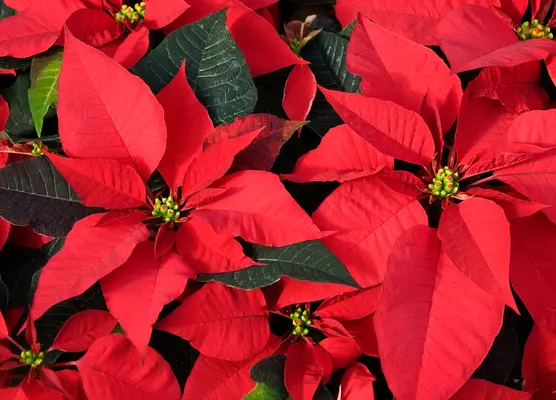Houseplants at Christmas

Poinsettia
- The favourite Christmas Houseplant usually red but they now come in pink white and marbelled too.
- Glendoick only sell Scottish grown Poinsettia as they hate travelling. Supermarket poinsettias usually die quickly as they have been trucked from round Europe and then they dont last.
- They need bright, but filtered light, away from strong sun and they hate draughts.
- Bes with a minimum temperature of 13-15°C (55-59°F) but they can take cool temperatures as long as it is not draughty or fluctuating.
- Be careful when transporting poinsettias from the shop to your home in the winter, as the cold outdoor temperatures can damage the foliage. If cold or windy ask for wrap for the plant.
- Do not overwater and keep water off the foliage but mist to keep humidity up.
- Very hard to get back into flower so usually thrown away after Christmas.
Houseplant Azalea
- Amazing range of colour: red, pink, purple white and bicolour. Double and Single.
- Plants for bright, cool conditions of around 10-15°C (50-59°F)
- Azaleas naturally bloom in spring, but they are forced into flower early for Christmas
- Grow in a cool location (does not like central heating) and keep moist. So not let the compost dry out. Place the container on a pebble tray or saucer to maintain humidity
- A sunny windowsill is an ideal position for azaleas during winter
- In mid-April, repot using an ericaceous compost. Plants can be stood outdoors in a cool, shady site for the summer but keep moist. Bring indoors before frosty weather.
Cyclamen
- Cyclamen should bloom for several months and can flower again in future years
- Select a plant with plenty of buds showing underneath the foliage. Avoid plants with drooping or yellow leaves, as they have often been overwatered.
- Choose a cool, brightly-lit situation, away from direct sunlight and heating
- Occasional drying out of the compost is less harmful than overwatering.
- Best watered from below using a saucer. Keep foliage and flowers dry.
- Remove spent flowers by twisting the stems.
- After flowering, continue careful watering and feeding until leaves yellow, then reduce watering as the plant becomes dormant for the summer.
- As new growth appears, replace the top few centimetres (half an inch) of compost in the container with fresh compost and resume regular watering



